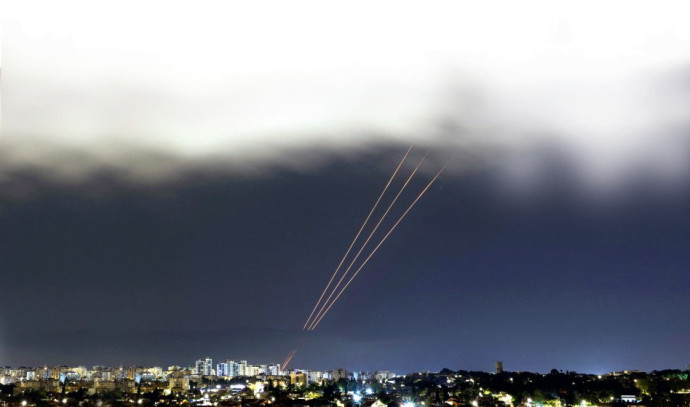Overwhelmed with the multifront crisis of Gaza-Hezbollah-Syria-Yemen-West Bank, Israel, the US, and the West are all stuck in reactive-mode when it comes to the varied threats posed by Iran.
Is it possible for Israel and its allies to map out a different strategy to set Iran back on its heels?
Two think tanks have put out some potential ideas to wrestle with, but there first is a three-part problem to comprehend.
While the Israel-West axis successfully shot down some 350 aerial threats that Iran fired on April 13-14, Tehran could try again, and it is not so clear that Jerusalem would do as well in a second or third round.
Problem one, then, is that Israel, the US, and the West are more vulnerable now than ever to direct conventional attacks – attacks that Iranian Supreme Leader Ayatollah Ali Khamenei did not attempt to carry out in the past.
A dead end on preventing Iran’s nuclear ambitions
Problem two is that the latest zigzagging between Iran, the nuclear inspectors from the International Atomic Energy Agency (IAEA), and the West, appears to have led to a dead end when it comes to Khamenei walking back his nuclear weapons program. Iran has no interest in back-tracking, and the West remains afraid to refer to the UN Security Council, to threaten a snapback of global sanctions.
Also, no one is even remotely contemplating a military attack, given that only Israel and the US have the capabilities for something like that, and America has opposed even the mild condemnation by the IAEA pushed through by European countries. Jerusalem’s response to the April attack was extraordinarily limited and defensive.
Rather than hurt Iran’s offensive or nuclear capabilities, Israel sufficed with striking Iran’s S-300 anti-aircraft system as a response. While this system is the prize of Tehran’s defenses, it is still only defensive and did not reduce Khamenei’s offensive options one iota.
The third problem is the war, and the price it is exacting on Israel: Jerusalem is bleeding in its regular fight against Iran’s proxies, while the Islamic Revolutionary Guard Corps (IRGC) in Iranian territory remains mostly immune.
Middle East scholar Barak Seener in a recent report that a key strategy Israel used was to make the Iranians bleed anytime their proxies challenged Jerusalem. The report was published by the Henry Jackson Society in England.
Although, in February 2022, former prime minister Naftali Bennett ordered the destruction of 125 Iranian drones following an attempt by an Iranian proxy attack on Israel with two drones, this policy did not continue for long or with any regular consistency and evaporated with the onset of the Gaza war.
Seener suggested that Israel, the US, and the allies attack Iran directly, and at a long list of targets: IRGC bases, Iran’s drone and missile facilities, its oil infrastructure – including refining and processing facilities, domestic distribution pipelines and terminals, and the hydrocarbon export ports and related facilities. He adds to this list Iran’s air defense capabilities – including airfields, command and control, and anti-aircraft batteries, and its nuclear program, including uranium conversion and uranium enrichment programs.
Critics of this approach would paint these suggestions as fantastical, or as pushing the region toward regional war.
But Seener argues that – besides acknowledging that a regional war is already afoot – all past evidence suggests that an appeasement-style attitude toward Khamenei has always led him to be more – not less – aggressive.
In contrast, he argues that when Iran is hit closer to home, it shocked and retreats – when its people must also bleed due to its machinations. Past evidence, he argues, supports this, such as the assassination of former IRGC Quds Force chief Qasem Soleimani.
This is certainly not a one-sided argument: the April attack showed that Iran was willing to directly strike Israel as payment for killing top IRGC Syria-Lebanon commander Mohammed Reza Zahedi.
In general, Seener’s argument of directly pushing back did seem to work at times, like in the Soleimani case, and in others where Bennett pursued a strategy like this one.
Seener’s readiness to go after a variety of Iranian targets – and not just nuclear ones – could create a spectrum of Iranian tolerance, just as Israel has had to accept gray lines (rockets to Sderot) and red lines (rockets to Tel Aviv).His report also advocates cyber attacks, and striking IRGC officials in proxy countries – strategies Israel has already pursued.
His report also advocates a long-term commitment to undermining the stability of Iran’s regime.
This was – again – something that Bennett pursued. It appears though, that the current Israeli government abandoned it, while other countries did not necessarily assist as much as they could have.
A different, more conventional view is offered by Sima Shina and Eldad Shavit, two former Israeli intelligence officials, now scholars at the Institute for National Security Studies out of Tel Aviv University.
They advocate coming to a quick end to the Gaza war, such that Israel, the US, and the West can refocus their energies on Iran – before it breaks out into a nuclear weapon.
Further, they hope that such a realignment of priorities will gain support for both economic sanctions and a viable military option to cage Tehran back into a nuclear box.
The INSS paper is mostly focused on nuclear issues, but the resolution of conflicts with Iran’s proxies would also clear the playing field, such that it would be harder for Tehran to attempt to evade responsibility for attacks on Israel.
Generally, INSS experts are more pessimistic about the prospect of destabilizing Iran’s regime; their long-term strategy would focus more on strengthening the diplomatic belt and expanding the Abraham Accords to Saudi Arabia and even other countries.
In contrast, Seener views the Abraham Accords as valuable on many fronts, especially defensive ones, but as not dealing directly enough, in a proactive way, with the threats posed by Iran, which he has detailed in a previous report by the same publication.
So, no one has yet figured out how to thread the needle to neutralize Iran’s many threats, but reports coming out in this critical period offer some potential ways forward.



)



